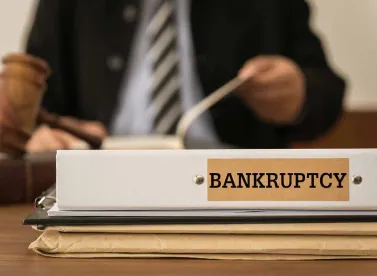On June 6, 2022, the U.S. Supreme Court issued its opinion in Siegel v. Fitzgerald, in which the Court held that the Bankruptcy Judgeship Act of 2017, Pub. L. 115-72, Div. B, 131 Stat. 1229 (the “2017 Act”) was unconstitutional. The 2017 Act required a significant, temporary increase of the fee rates paid into the United States Trustee System Fund (the “UST Fund”) by debtors in large chapter 11 cases.[1] Underlying the Court’s holding is the Bankruptcy Clause of the Constitution (Article I) which gives Congress the power “to establish… uniform laws on the subject of bankruptcies throughout the United States.” The Court held that the 2017 Act was unconstitutional because the fees were not uniformly applied. Perhaps most interestingly, the Court did not decide on a remedy. Instead, it remanded the proceeding back to the Fourth Circuit Court of Appeals alongside a $325 million[2] question: “Now what?”[3]
Background
Originally, bankruptcy judges handled the administrative duties of bankruptcy cases.[4] This intertwining of administrative and judicial tasks resulted in an extensive workload as well as the appearance of bias with bankruptcy judges overseeing the trustees they had appointed.[5] To address these concerns, Congress created the United States Trustee Program (the “Trustee Program”) in 18 of the 94 federal judicial districts.[6] After eight years, Congress expanded the Trustee Program to nearly every district, excepting only the six districts in North Carolina and Alabama.[7] For those two states, Congress temporarily permitted the judiciary to continue judicial oversight of administrative tasks under the Bankruptcy Administrator Program (the “Administrator Program”).[8] Eventually, Congress made the Administrator Program permanent.[9]
The Trustee Program is funded by fees paid by debtors into the UST Fund, and the Administrator Program is funded by the Judiciary’s general budget.[10] The resulting discrepancy in payments, with the Trustee Program being more costly to debtors, led the Ninth Circuit Court of Appeals to hold the 2017 Act unconstitutional.[11] In response, Congress gave the Judicial Conference of the United States (the “Judicial Conference”) the discretion to impose the same fees on a chapter 11 debtor under the Administrator Program as a debtor under the Trustee Program.[12] The Judicial Conference used its discretion to do so.[13] This arrangement equalized the fees paid in the two systems until Congress enacted the 2017 Act to address fund shortages in the Trustee Program, which increased fees in the first quarter of 2018 for all pending chapter 11 cases.[14] The six districts operating the Administrator Program did not enact those fees until October 1, 2018 and then only applied such fees to newly-filed cases.[15] This then left debtors governed by the Administrator Program paying less than debtors governed by the Trustee Program. This discrepancy led the Supreme Court in Siegel to strike down the 2017 Act as unconstitutional.[16] However, it also left open the question of how to remedy the discrepancy in payments paid pursuant to the 2017 Act.[17]
Possible Solutions to the Question of “Now What”
There appear to be three possible courses of action following the Court’s decision: (1) refunding the money, (2) retroactively raising the fees on debtors who filed chapter 11 cases in the states using the Administrator Program; or (3) doing nothing. Each of these potential remedies has some benefits, but also carries with it a malady that courts will need to address.
Refunding the money may be the most common sense solution. The two circuit courts that previously ruled the 2017 Act unconstitutional ordered the bankruptcy court to provide the plaintiff debtors with a refund of the amount of quarterly fees paid in excess of the amount they would have paid in a district using the Administrator Program during the same time period.[18] However, implementing a refund on a nationwide scale carries with it fairness and practicality concerns.[19] First, it could potentially result in the divestment of extremely large portions of the reserves the Trustee Program maintains in its UST Fund. Congress initially raised the fees in response to concerns about a shortfall in the UST Fund. Depleting the funds in order to refund overpayments could result in a new, and even larger, fee increase from Congress (this time uniformly applied) and would be a pyrrhic victory for current debtors and a decisive loss for future debtors. Further, courts would have to reopen many old cases and then answer the question of what to do with the money after it is refunded (for instance, how would a refund be paid to a liquidating trustee for a trust that has long since been dissolved?).
Retroactively raising fees on debtors who filed in exempted states would theoretically be simpler to implement due to the smaller number of affected parties: only 6 out of the 94 judicial districts are currently exempted. However, this would raise substantial due process concerns. For example, in the context of a tax increase, the Supreme Court has stated that a retroactive tax assessment could be “so harsh and oppressive as to transgress constitutional limitation[s].”[20] While it cannot be stated that retroactively raising fees would definitively create a due process violation, it can be stated definitively that a harsh retroactive application would result in a large amount of litigation.
Even doing nothing carries with it the specter of injustice. Leaving uncorrected the imbalance created by the unconstitutional 2017 Act offers no relief to those who paid the higher fees, and it allows the government-created Trustee Program to reap the fruits of an unconstitutional law. In Montana National Bank of Billings v. Yellowstone County, the Supreme Court examined what to do with money collected under a discriminatory tax law after the state court held the tax unconstitutional but declined to order a refund.[21] The Supreme Court stated that fixing the law but not ordering a remedy “did not cure the mischief.”[22] Here, similarly, granting only prospective relief would not cure the mischief.
One possible guide point in this thicket is the Supreme Court holding in McKesson Corp. v. Div. of Alcoholic Bevs. & Tobacco.[23] In McKesson, the State of Florida enacted a tax that violated the Commerce Clause by imposing a higher tax burden on sales of alcoholic beverages that did not utilize Florida products than those that did.[24] The taxpayer sought a refund of the “amount of the excess taxes it had paid as a result of its disfavored treatment.”[25] The Supreme Court had to determine what remedy to apply. In analyzing the situation, the Court concluded that there were three possible remedies: (1) refunding the difference between the tax the petitioning taxpayer paid and the tax of the favored class; (2) assessing and collecting back taxes from that favored class to “create in hindsight a nondiscriminatory scheme”; and (3) “a combination of a partial refund . . . and a partial retroactive assessment,” as long as the tax assessed during the discriminatory period “reflects a scheme” that does not violate the Constitution.[26] The Court ultimately remanded the case to the Florida courts, reinforcing that “[t]he State is free to choose which form of relief it will provide, so long as it satisfies the minimum federal requirements.”[27]
The Fourth Circuit will now find itself playing the same role as the Florida courts did in McKesson—it will have to fashion a form of relief that satisfies the Constitution without violating Due Process. Perhaps the easiest solution, if all potential plaintiffs are taken into consideration, will be the third McKesson option, implementing both a partial refund as well as a partial retroactive assessment. While this solution will make no one happy, and carries with it its own administrative burden, it is likely the only solution that remedies the constitutional violation without creating a catastrophic situation for the Trustee Program and without infringing upon the due process rights of the debtors who filed chapter 11 cases in the states using the Administrator Program. Regardless of the Fourth Circuit’s answer, litigation is likely to continue for many years as the judicial system wrestles with fixing this constitutional error. The question of “now what?” is not likely to go away any time soon.
ENDNOTES
[1] See Pub. L. 115-72, Div. B, 131 Stat. 1229.
[2] See Vince Sullivan, Justices’ US Trustee Fee Ruling Could Wreak Ch. 11 Havoc, Law 360 Bankruptcy, https://www.law360.com/bankruptcy/articles/1500307/justices-us-trustee-fee-ruling-could-wreak-ch-11-havoc (last updated June 7, 2022) (“[E]xperts say dealing with the $500,000 in excess fees paid by the trust—which extrapolates to nearly $325 million for all similarly situated debtors—presents several options that come with serious pitfalls.”).
[3] Siegel, 596 U.S.___, at 15 (2022).
[4] See H.R. Rep. No. 99-764, p. 17 (1986).
[5] Id. at 17-18.
[6] See Bankruptcy Reform Act of 1978, Pub L. No. 95-598, 92 Stat. 2549, 2662-65 (1978).
[7] See Family Farmer Bankruptcy Act of 1986, Pub. L. No. 99-554, 100 Stat. 3088, 3090-95 (1986); Siegel, 596 U.S. at 2.
[8] §§ 11-115, 302(d)(3), 100 Stat. 3090-3095, 3121-3123.
[9] § 501, 114 Stat. 2421-2422 (2000 Act); §302(d)(3), 100 Stat. 3121-3123.
[10] See Siegel, 596 U.S. at 3; see also 28 U.S.C. § 589a(b)(5);
[11] St. Angelo v. Victoria Farms, Inc., 38 F.3d 1525, 1532-1533 (1994), as amended, 46 F.3d 969 (1995).
[12] 2000 Act § 105, 114 Stat. 2412 (enacting 28 U.S.C. § 1930(a)(7)).
[13] See Report of the Proceedings of the Judicial Conference of the United States 45-46 (Sept/ Oct. 2001) https://tinyurl.com/2001-jud-conf-report.
[14] See Pub. L. 115-72, Div. B, 131 Stat. 1229.
[15] See Siegel, 596 U.S. at 4-5.
[16] Id. at 13-15.
[17] In 2021, Congress removed the Judicial Conference’s discretion of whether or not to impose fees in the Administrator Program that are equal to those of the Trustee Program by making the imposition mandatory. See Pub. L. 116-325, 134 Stat. 5088.
[18] See Clinton Nurseries of Md., Inc. v. Harrington (In re Clinton Nurseries, Inc.), 998 F.3d 56, 64-70 (2d Cir. 2021); John Q. Hammons Fall 2006, LLC v. Office of the U.S. Tr. (In re John Q. Hammons Fall 2006, LLC), 15 F.4th 1011, 1021-1026 (10th Cir. 2021).
[19] If the Fourth Circuit does not look at the potential remedy through a nationwide lens, one court will likely eventually need to do so.
[20] McKesson Corp. v. Div. of Alcoholic Bevs. & Tobacco, 496 U.S. 18, 40 n. 23 (1990).
[21] Montana National Bank of Billings v. Yellowstone County, 276 U.S. 499 (1928).
[22] Id. at 34.
[23] 496 U.S. 18 (1990).
[24] Id. at 23.
[25] Id. at 24-25.
[26] Id. at 40-41.
[27] Id. at 51.




 />i
/>i
